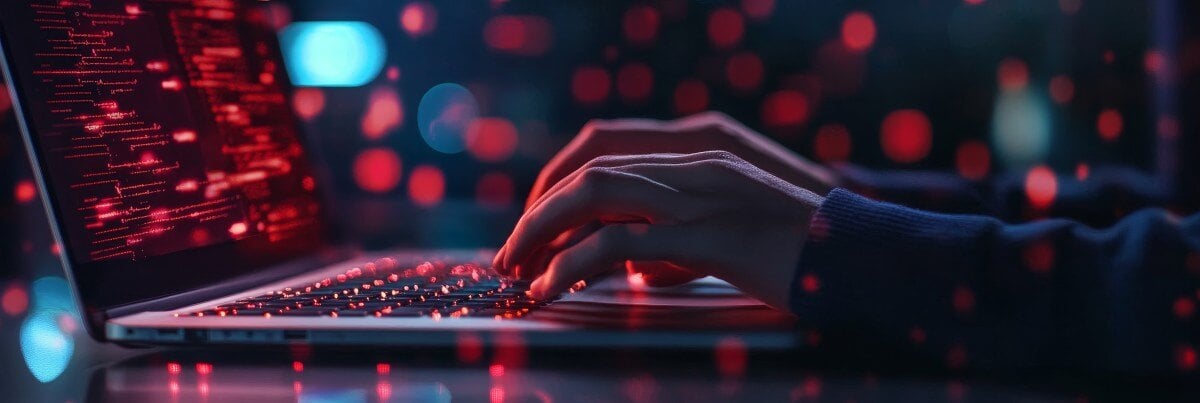Using Patient Education Videos to Support Preventive Care Strategies
As a healthcare provider, you know prevention saves lives. From routine screenings and lifestyle counseling to vaccinations and early detection,...
7 min read
Robert McDermott Oct 31, 2024 12:45:00 PM
 Once the lights are shut off, the doors locked, the exam rooms empty, and the hum of day to day silenced, you may think your practice is quiet and secure. The reality? Your practice isn’t safe and likely isn’t as quiet as you think.
Once the lights are shut off, the doors locked, the exam rooms empty, and the hum of day to day silenced, you may think your practice is quiet and secure. The reality? Your practice isn’t safe and likely isn’t as quiet as you think.
We’re not talking about phantom patients or ghost doctors and dentists, unexplained sounds, or mysteriously misplaced items. The healthcare industry is facing a frightening rise in cybersecurity threats, with cyber attacks becoming more relentless.
Quick Links:
Much like the survivors in "The Walking Dead," the healthcare industry is under siege. Like waves of zombies, healthcare is assaulted by relentless waves of cybersecurity threats which seem to be multiplying faster than ever, always coming from new directions.
The cybersecurity data from the past few years demonstrates a chilling trend—as attacks increase, so do the size of the attacks, in regards to the number of records exposed. Further, 2023 included records for both the number of breaches as well as the number of records exposed.
As these threats rise like the walking dead, healthcare organizations must fortify their defenses. Practices must avoid being stalked by poor security decisions from the past because the consequences of being unprepared are growing more dire with each passing day. The question is no longer *if* these threats will come knocking at your door—it’s *when.*
 The Haunted: What Makes Healthcare Organizations Such Great Cyber Attack Targets?
The Haunted: What Makes Healthcare Organizations Such Great Cyber Attack Targets?Every ghost story starts with something of value– a haunted place, a haunted item, and, in some cases, a haunted person. Healthcare data is no different; it’s high value for hackers—a vault of sensitive personal, financial, and medical information. Like ghosts drawn or attached to valuable items, cybercriminals are increasingly targeting healthcare practices because healthcare data is worth far more on the black market than any other industry.
More specifically, while Personally Identifiable Information (PII) may be worth a dollar or two on the black market, Private Health Information (PHI), in contrast, may be worth hundreds of dollars. As a result, healthcare has become a goldmine for malicious actors seeking to profit off personal health data, leading to more frequent and sophisticated attacks.
And, much like the house in Poltergeist, built on a graveyard and begging for issues, many practices have a tech foundation haunted by outdated security measures, legacy systems, and underfunded IT teams. However, the compound annual growth rate (CAGR) of this digital transformation is estimated to be over 32% with a value of 1183.2 billion by 2030.
While this growth rate is fantastic, given the value of digital transformation for all aspects of a healthcare practice (and patients), it does introduce one complicating factor: an increased attack surface.
As healthcare embraces digital transformation to improve efficiency, some are unwittingly inviting these threats into their operations, opening doors that should remain tightly sealed.
In Nightmare on Elm Street, Nancy must first understand the threat Freddy Krueger poses before she is able to neutralize it (and help others do the same). Like Freddy, healthcare cybersecurity threats often remain unseen but deadly. Unlike Freddy, they don’t just come at night.
But, like the last person standing in a slasher flick, you need not fall prey to attacks. Understanding the risks (staying out of the basement) can help you prepare the best defense.
In the Saw franchise, the serial killer Jigsaw holds his victims hostage, requiring them to make difficult, often life-threatening choices, to survive. Ransomware functions in a similar way.
Much like most horror movies, healthcare ransomware attacks often begin with a harmless action, like opening a malicious email attachment or clicking a link from a phishing scam, inviting the ransomware into the system. In some cases, attackers gain access through weak passwords or compromised credentials, enabling them to bypass security measures.
Once inside, malicious software can spread, encrypting files and locking access to critical data. Some attacks exploit vulnerabilities in outdated software or unpatched systems, creeping in unnoticed until it’s too late.
To protect against this menace, healthcare organizations must implement strong data encryption, regularly back up data, and ensure HIPAA compliant cloud backup. Multi-factor authentication (MFA) adds an additional barrier, while employee training can help staff recognize suspicious emails or attachments. Finally, keeping software up to date and patching vulnerabilities can close the doors that ransomware often uses to sneak in, keeping this digital phantom at bay.
A common theme in horror movies is that an everyday action suddenly becomes terrifying, such as a tropical boat excursion made dangerous by a ferocious monster. Phishing attacks are quite similar.
Phishing attacks in healthcare often begin with a deceptive email, designed to look legitimate but laced with malicious intent. Cybercriminals craft emails that appear to come from trusted sources—such as coworkers, vendors, or even government agencies—tricking recipients into clicking malicious links or downloading infected attachments. Once clicked, these traps can lead to stolen credentials, access to sensitive patient data, or even the spread of ransomware across the network.
To protect against phishing, healthcare organizations should implement email filtering tools that detect and block suspicious messages, such as a secure HIPAA compliant email provider. Further, employee training is key, teaching staff how to spot phishing attempts, such as strange email addresses, poor grammar, or urgent requests for personal information. Additionally, using multi-factor authentication (MFA) can prevent hackers from accessing systems even if they obtain login credentials.
“The call is coming from inside the house.” The fear is real for Carol Kane in this 1979 thriller. And, for healthcare providers who learn that one of the biggest threats to their security is already inside the organization, the realization can be scary.
Insider attacks in healthcare occur when employees or trusted individuals misuse their access to sensitive data or systems for malicious purposes. These insiders—whether disgruntled staff, contractors, or even partners—can steal patient information, tamper with records, or sell data on the black market. Sometimes, the attack is intentional; other times, it's a result of negligence, such as sharing login credentials or falling for phishing schemes that expose the network to outside threats.
To protect against insider attacks, healthcare organizations must implement strict access controls—only giving employees the minimum access they need to perform their duties. Similarly, strict monitoring tools can track user activity to help identify suspicious behavior, while regularly auditing access logs ensures potential issues are caught early. Additionally, creating a strong security culture through employee education can reduce the chance of negligence leading to a costly breach.
In 1980’s The Fog, a town is taken over by a mysterious cloud. Healthcare operations are increasingly shifting to the cloud, bringing cloud security concerns to the forefront.
The main fear? That sensitive patient data stored in the cloud could be exposed to cyberattacks, unauthorized access, or breaches. With the cloud often accessible from anywhere, some fear losing control over their data, facing compliance issues, or suffering devastating leaks due to misconfigurations or weak security practices.
To protect healthcare data in the cloud, organizations must choose cloud providers with strong security measures, including end-to-end encryption, HIPAA compliance, and regular security audits. Implementing robust access controls—such as multi-factor authentication (MFA) and role-based permissions—can ensure that only authorized personnel can access critical data.
Further, continuous monitoring and logging of cloud activities also help detect any unusual behavior, while frequent reviews of security settings can help avoid misconfigurations that leave data vulnerable. With these precautions, healthcare practices can embrace the cloud without fear of their data disappearing into the fog.
In the cult classic, The Texas Chainsaw Massacre, a series of disconnected but adjacent events puts a carload of teenagers in serious peril. In healthcare, supply chain attacks occur when cybercriminals infiltrate third-party vendors or providers. They use the compromised supplier as a Trojan horse to gain access to a healthcare network. Once inside, they can steal sensitive data, disrupt services, or introduce ransomware, causing widespread damage.
To protect against supply chain attacks, healthcare organizations should thoroughly vet all vendors and ensure they comply with strong cybersecurity standards. Further, a HIPAA required Business Associate Agreement (BAA) can help ensure your vendors and partners are maintaining strict security safeguards.
Additionally, implementing network segmentation—isolating critical systems from supplier access—limits the damage if a vendor is compromised. Continuous monitoring and updating security policies across the entire supply chain is key to defending against these hidden threats.
 6. Pulse: IoT Devices
6. Pulse: IoT DevicesPulse, a 2001 Kurosawa J-horror movie, remade in the US in 2006 and, perhaps loosely based on Stephen King’s The Cell, centers on how mobile technology can be used to initiate larger cyber attacks.
Internet of Things (IoT) devices, such as connected medical equipment, wearables, and monitoring systems, offer tremendous benefits to healthcare—but they also open new doors for cyberattacks. These devices often lack strong built-in security and can be exploited by hackers to gain unauthorized access to a network, launch ransomware, or steal sensitive patient data. Since IoT devices are widely connected to healthcare systems, an attack on one device can potentially spread throughout the network.
To protect against IoT-related attacks, healthcare organizations must ensure that all devices are regularly updated with the latest security patches. Implementing strong encryption protocols for data transmitted between devices, as well as segmenting IoT devices from critical systems on the network, helps contain any potential breaches. Additionally, using IoT device management solutions to monitor and secure connected devices can further reduce vulnerabilities and protect patient data from falling into the wrong hands.
In 2013’s The Purge, citizens must develop strict security measures to protect themselves and their property from a “legalized” day of lawlessness.
HIPAA laws were put in place to offer protections to patients and prevent privacy and security threats. Non-compliance, or a failure to protect from a data breach, can result in hefty fines, legal consequences, and severe reputational damage. HIPAA compliance risks often arise from unsecured data storage, improper access controls, inadequate employee training, or failing to report breaches promptly. Even minor slip-ups, like sharing patient information via unsecured channels, can lead to devastating consequences.
To protect against HIPAA security risks, healthcare practices must implement strict security measures, such as encrypting all sensitive data and ensuring access is granted only on a need-to-know basis. Conducting regular HIPAA security risk assessments and audits helps identify vulnerabilities before they lead to violations.
Additionally, comprehensive staff training on HIPAA regulations and data security can minimize the risk of accidental breaches.
2004’s I, Robot is set in 2035, when AI and intelligent robots are filling a good number of roles in society and potentially pose a serious threat.
In the movie, it’s clear that both AI and automation offer immense benefits to society and the same is true for healthcare. From streamlining operations and enhancing patient care to improving decision-making, they’ve reshaped the way practices operate. However, they also come with inherent risks.
These risks include data privacy concerns, algorithmic bias, and potential system failures that could disrupt critical healthcare services. If not properly managed, these technologies can inadvertently expose sensitive patient information or lead to incorrect diagnoses and treatment recommendations.
To protect against AI and automation risks, healthcare organizations should prioritize transparency in their AI systems, ensuring algorithms are regularly tested for accuracy and fairness. Implementing strict data governance policies also helps safeguard patient privacy and ensure compliance with regulations.
Continuous monitoring of AI outputs can also help identify and rectify any biases or inaccuracies promptly. Additionally, providing staff training on the limitations and ethical considerations of AI will foster a culture of caution and diligence, ensuring that technology enhances rather than undermines patient care.
At the end of the horror movie that is healthcare cybersecurity threats, there will be few characters who remain untouched. At the end of a horror movie, the lead, the hero, isn’t completely unscathed, but smart choices, as well as the right tools and resources, often help them survive.
If you’re looking for the right tools and resources to help you strengthen your healthcare cybersecurity posture, get in touch with the team at iCoreConnect. From HIPAA secure email to HIPAA risk assessments and more, we designed our solutions with healthcare security at the forefront. Reach out to our team today and let’s end the terror and introduce tighter security.

As a healthcare provider, you know prevention saves lives. From routine screenings and lifestyle counseling to vaccinations and early detection,...

There’s no denying that the AI boom is here. The American Medical Association reports that 66% of physicians are currently using artificial...

If only managing your practice’s revenue cycle came with a crystal ball. You could spot claim denials before they happen, predict when patients might...

Technology is great when it performs as intended, but what about when it doesn’t deliver? Or worse, what happens when it leaves us exposed to...

We’ve all had mornings when we open our email and the sheer number of new messages is overwhelming. So, we move through them quickly, hoping to...

Most healthcare practices wouldn’t dream of forgoing malpractice insurance. It’s a necessity to keep a practice safe. And yet, many practices take a...